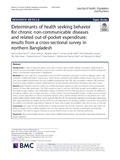Determinants of health seeking behavior for chronic non-communicable diseases and related out-of-pocket expenditure: results from a cross-sectional survey in northern Bangladesh

View/Open
Date
2019-12-23Publisher
BMCAuthor
Binte Rasul, FatemaKalmus, Olivier
Sarker, Malabika
Adib, Hossain Ishrath
Hossain, Md Shahadath
Hasan, Md Zabir
Brenner, Stephan
Nazneen, Shaila
Islam, Muhammed Nazmul
De Allegri, Manuela
Metadata
Show full item recordCitation
Rasul, F. B., Kalmus, O., Sarker, M., Adib, H. I., Hossain, M. S., Hasan, M. Z., . . . De Allegri, M. (2019). Determinants of health seeking behavior for chronic non-communicable diseases and related out-of-pocket expenditure: Results from a cross-sectional survey in northern Bangladesh. Journal of Health, Population and Nutrition, 38(1) doi:10.1186/s41043-019-0195-zAbstract
Background: In spite of high prevalence rates, little is known about health seeking and related expenditure for
chronic non-communicable diseases in low-income countries. We assessed relevant patterns of health seeking and
related out-of-pocket expenditure in Bangladesh.
Methods: We used data from a household survey of 2500 households conducted in 2013 in Rangpur district. We
employed multinomial logistic regression to assess factors associated with health seeking choices (no care or selfcare, semi-qualified professional care, and qualified professional care). We used descriptive statistics (5% trimmed
mean and range, median) to assess related patterns of out-of-pocket expenditure (including only direct costs).
Results: Eight hundred sixty-six (12.5%) out of 6958 individuals reported at least one chronic non-communicable
disease. Of these 866 individuals, 139 (16%) sought no care or self-care, 364 (42%) sought semi-qualified care, and
363 (42%) sought qualified care. Multivariate analysis confirmed that the following factors increased the likelihood
of seeking qualified care: a higher education, a major chronic non-communicable disease, a higher socio-economic
status, a lower proportion of chronic household patients, and a shorter distance between a household and a subdistrict public referral health facility. Seven hundred fifty-four (87 %) individuals reported out-of-pocket expenditure,
with drugs absorbing the largest portion (85%) of total expenditure. On average, qualified care seekers encountered
the highest out-of-pocket expenditure, followed by those who sought semi-qualified care and no care, or self-care.
Conclusion: Our study reveals insufficiencies in health provision for chronic conditions, with more than half of all
affected people still not seeking qualified care, and the majority still encountering considerable out-of-pocket
expenditure. This calls for urgent measures to secure better access to care and financial protection.
